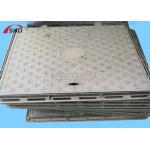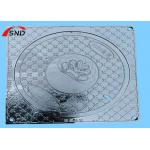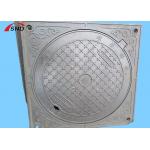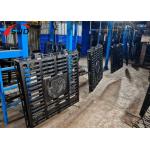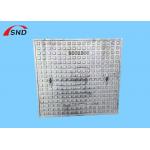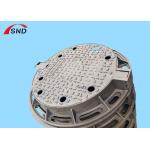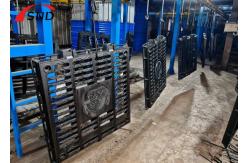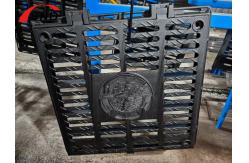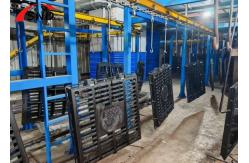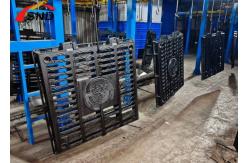Ductile Iron Rainwater Drainage Manhole Cover For Municipal Use
The production process of ductile iron manhole covers mainly
includes the following steps:
Raw material preparation:
Main material: Select pig iron, scrap steel, and recycled materials
(unqualified products recovered in production, pouring risers,
etc.). Pig iron provides carbon and basic iron elements, scrap
steel adjusts the composition of molten iron, and recycled
materials reduce costs and improve efficiency.
Auxiliary materials: Add alloy elements such as silicon, manganese,
and copper to improve performance, add spheroidizing agents such as
magnesium and rare earth, and inoculants such as ferrosilicon to
ensure spheroidizing effects.
Inspection: Raw materials are tested at the factory to ensure that
the content of elements such as carbon, silicon, manganese,
phosphorus, and sulfur and the composition of spheroidizing agents
and inoculants meet production requirements.
Smelting:
Charging: Load pig iron, scrap steel, and recycled materials into
the smelting furnace (cupola/electric furnace) in proportion.
Generally, pig iron is put first, and then scrap steel and recycled
materials are put to avoid the influence of impurities.
Temperature control: Melting temperature is 1450 - 1550℃ (higher
than ordinary gray cast iron), so that the raw materials are fully
melted and the composition is uniform, which is conducive to
subsequent processing.
Adjusting composition: Continuously detect and adjust the
composition of molten iron during smelting to ensure that the
content of elements such as carbon and silicon is suitable. For
example, too high carbon increases brittleness, too low affects
spheroidization; too high silicon reduces strength, too low affects
fluidity.
Spheroidization and inoculation treatment:
Spheroidization: After the molten iron is melted, add spheroidizing
agent (magnesium, rare earth, etc.) according to 1% - 2% of the
mass of the molten iron, use the flushing method (put the bottom of
the molten iron ladle, quickly flush the molten iron to react) or
the transfer method (the molten iron is poured into the transfer
ladle, and then put into the casting mold after adding the agent),
react for 3 - 5 minutes, let the graphite become spherical, improve
strength, toughness and wear resistance.
Inoculation: After spheroidization, add inoculant (ferrosilicon,
etc.) according to 0.3% - 0.8% of the molten iron mass, use flow
inoculation (add during pouring) or ladle inoculation (add in the
molten iron ladle and pour after pouring) to refine the graphite
balls and improve the mechanical properties. Metallographic
analysis and hardness test can also be performed to detect the
effect.
Casting and molding:
Mold preparation: Use sand mold (good air permeability and
yieldability), and make the mold according to the manhole cover
design to ensure molding and prevent cooling cracks.
Temperature control and speed regulation: Due to the poor fluidity
and large shrinkage of ductile iron, the pouring temperature is
1350 - 1450℃, and the speed is moderate. Too fast and easy to
splash, too slow and easy to low temperature, resulting in poor
pouring.
Set riser chill: The riser stores excess molten iron to make up for
solidification shrinkage; chill accelerates cooling and improves
quality.
Cooling:
Method: After pouring, let the manhole cover cool naturally in the
mold (several hours to dozens of hours, depending on the size and
thickness), and it can also be assisted by forced cooling and spray
cooling.
Speed control: Cooling speed affects performance. Too fast is
easy to produce white structure (reduced toughness and wear
resistance), too slow is easy to coarse grains (reduced strength),
and the speed needs to be reasonably controlled according to the
material and size.
Post-processing:
Sand cleaning: Use a vibrating sand-dropping machine, a
sandblasting sand-dropping machine, etc. to separate the casting
from the sand mold, clean the surface/internal impurities and
burrs, and there are mechanical (high efficiency but easy to damage
the surface) and manual (maintain surface quality but slow) sand
cleaning methods.
Cutting and grinding: flame and plasma cutting of large manhole
covers; grinding the surface, removing burrs and flash, making the
surface smooth, using grinding wheels, sand belts and other tools.
Heat treatment: annealing, normalizing, quenching and tempering,
etc., to change the internal structure and performance, improve
hardness, strength, wear resistance, etc.
Anti-corrosion treatment: spraying asphalt paint, galvanizing,
thermal spraying, electrostatic spraying, etc., to enhance
corrosion resistance and aesthetics. For example, underground
manhole covers are often treated with asphalt for corrosion
protection.
Quality inspection:
Appearance: Check whether the surface has cracks, pores, sand
holes, whether it is smooth, and whether the size meets the
standard.
Performance: tensile, bending, and impact tests are performed to
measure mechanical properties; load-bearing, fatigue resistance,
and corrosion resistance tests are performed according to EN124 and
other standards, such as D400 grade to measure 40 tons of load
bearing capacity.
Spheroidization rate: metallographic analysis measures the graphite
spheroidization rate (generally required to be ≥80%) to measure the
quality of ductile iron.
Finished product packaging and storage:
After passing the inspection, it is packaged with plastic film,
cartons, etc. to prevent damage during transportation and storage.
Finished product warehouses are classified by specifications and
models, waiting for shipment.
